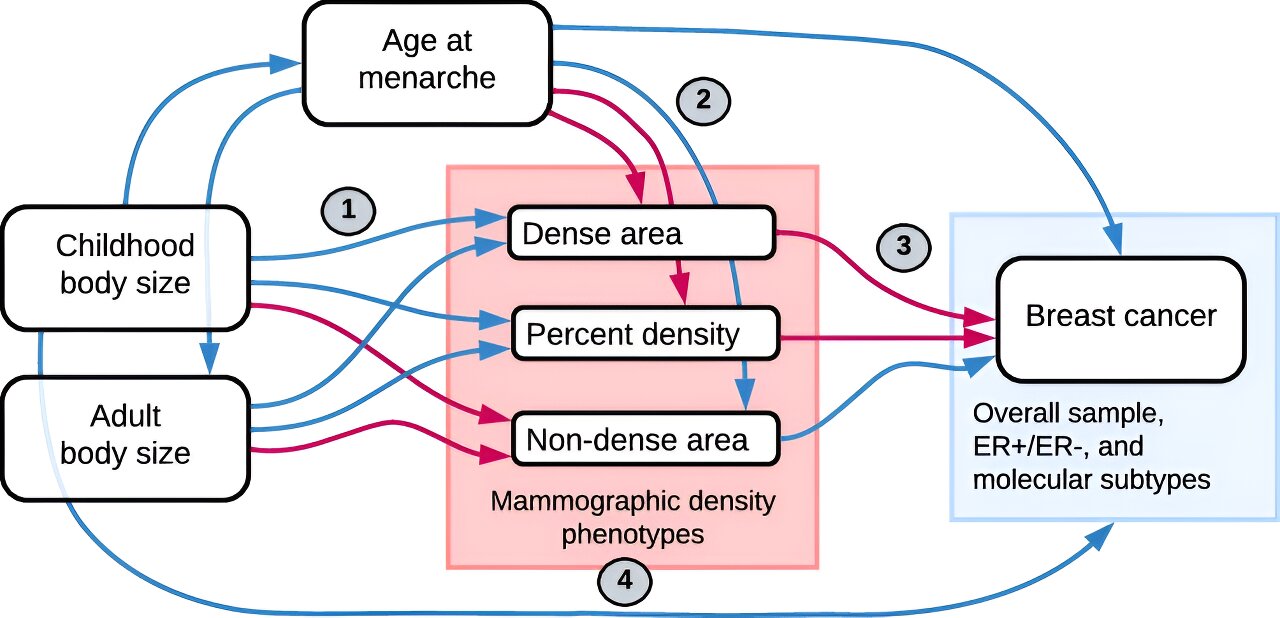Breast cancer is the most common cancer in women worldwide. With rates continuing to rise, there is an urgent need to identify new modifiable breast cancer risk factors. New research led by the University of Bristol suggests that higher adiposity in childhood leads to less dense breast tissue forming, which results in a reduced breast cancer risk. However, further research is needed to understand the mechanism of the overall protective effect of childhood adiposity to identify new targets for intervention and prevention.
The study, published in Nature Communications, explored the unexplained protective effect of higher body size in childhood on breast cancer risk using Mendelian randomization, to examine the connections between body size in childhood and adulthood, puberty onset timing, breast tissue density, and breast cancer risk.
The research team looked in more detail at one of the most plausible connections—breast tissue density. Higher breast density, measured with a mammogram, is an established risk factor for breast cancer, and is known to be affected by body size.
When a mammogram shows dense breast tissue, it means there’s a higher proportion of glandular or fibrous tissue compared to fatty tissue. Conversely, when breast tissue is less dense, there’s more fatty tissue relative to glandular or fibrous tissue.
There is growing evidence that adiposity in childhood can lead to various adult diseases. However, in the case of breast cancer risk, observational epidemiological studies, and more recently studies that used genetic data, have shown that higher body size in childhood decreases the risk of developing this disease.
The researchers used data from genome-wide association studies (GWAS) and Mendelian Randomization analysis. They were able to demonstrate that over 50% of the protective effect that higher childhood body size has on breast cancer risk is explained by the changes in dense breast tissue.
The research team suggest that a higher body size in childhood, around the start of puberty, leads to less dense tissue forming in the breast. The dense area is the part of the breast (glandular and fibrous tissue) where cancer normally develops.
Having less dense area in the breast subsequently leads to a reduced breast cancer risk in adulthood. This is the proposed mechanism by which higher childhood body size decreases breast cancer risk. However, the biological mechanism/pathway is more complex than this, and identifying smaller steps in this process using genetic data is a part of uncovering the basis of this unexplained causal relationship.
Dr. Marina Vabistsevits from the University of Bristol’s MRC Integrative Epidemiology Unit (MRC IEU) and Bristol Medical School: Population Health Sciences (PHS), and corresponding authors, said, “Studying the mechanism of childhood adiposity protective effect is important, as weight gain in childhood cannot be considered to be a preventative measure for breast cancer.
“Investigating how this overall ‘protection’ works is crucial to understand the underlying mechanisms leading to and preventing cancer, as it might help identify new targets for intervention and prevention.”
The study was possible thanks to a collaboration with Icahn School of Medicine at Mount Sinai and Kaiser Permanente Northern California, US, who shared invaluable mammographic density data for this project.
More information:
Marina Vabistsevits et al, Mammographic density mediates the protective effect of early-life body size on breast cancer risk, Nature Communications (2024). DOI: 10.1038/s41467-024-48105-7
Citation:
Adiposity in childhood affects the risk of breast cancer by changing breast tissue composition, study suggests (2024, May 14)
retrieved 14 May 2024
from https://medicalxpress.com/news/2024-05-adiposity-childhood-affects-breast-cancer.html
This document is subject to copyright. Apart from any fair dealing for the purpose of private study or research, no
part may be reproduced without the written permission. The content is provided for information purposes only.
